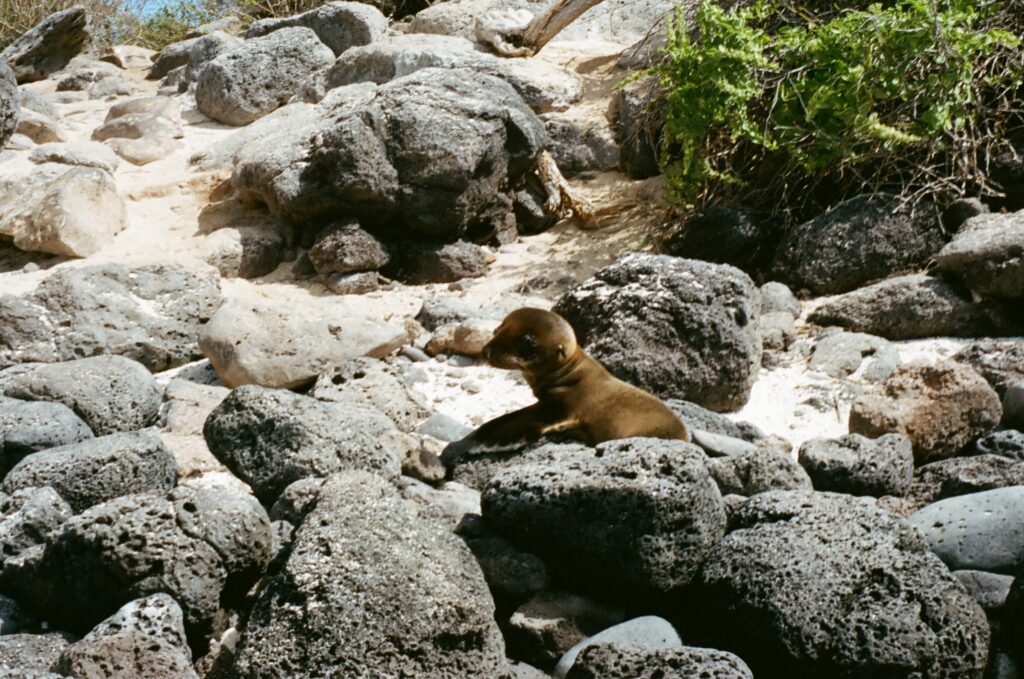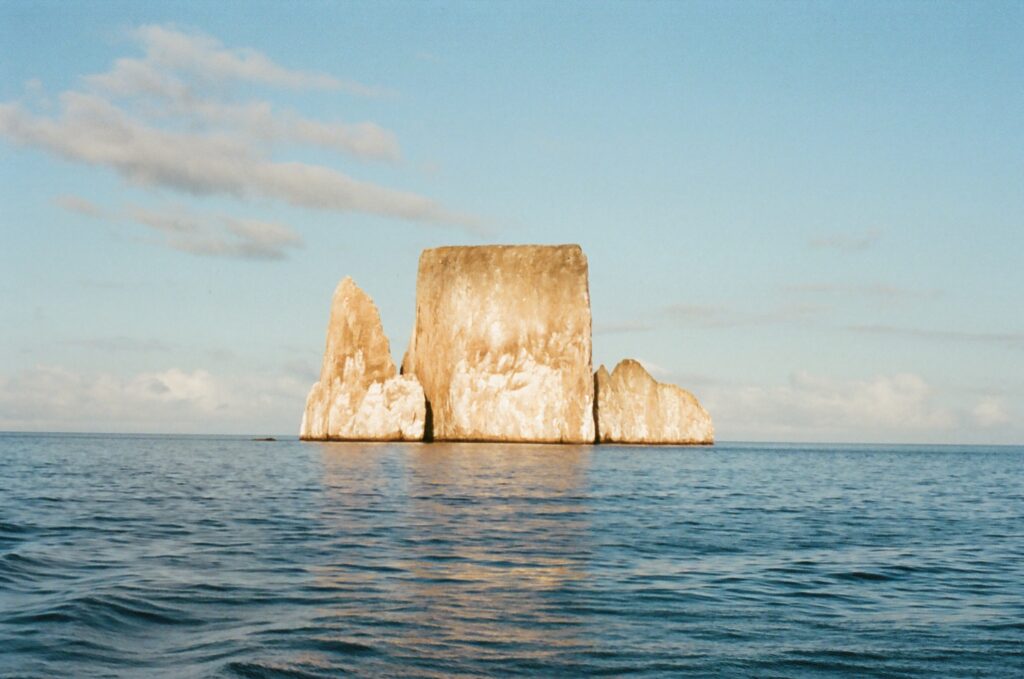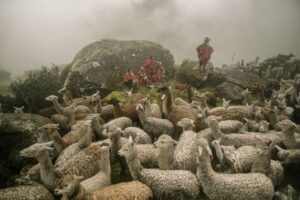Established in 1959, the Galapagos Islands is Ecuador’s oldest National Park. Renowned for each island’s unique flora and fauna, which inspired Charles Darwin’s Theory of Evolution, most tourists are attracted by the underwater life that surrounds the Islands. This is thanks to the Galapagos Marine Protected Area (MPA) that was established in 1998, and turned the islands into an important refuge for marine wildlife, which is sharply declining throughout the world.
In January, I travelled to the Galapagos and boarded a small sailboat that promised a low-impact tour of the isles. In Puerto Ayora, Santa Cruz, I was greeted by our naturalist guide, Johnny Alvarez, who took care of us on our ten day journey visiting the wonders of the Galapagos National Park.
“Life has been so beautiful and so peaceful here.”
Johnny is a family man, born and raised in Santa Cruz in the third generation of a family of Galapagos residents and fishers. When he was a teenager he was told to kill a sea lion that was caught in a net, an experience that inspired him to train to become a guide instead. After fifteen years guiding tourists among the wonders of the Galapagos, Johnny has gathered a wealth of knowledge. I ask him if anything has changed with the increase in tourism?
“Galapagos is becoming something different, a place that everyone uses to make a lot of money. There are many companies from many parts of the world that have come to the Galapagos. And we, the people who live here, who were born and raised in this beautiful place, feel that many are taking advantage of the Galapagos, including NGOs. There are several NGOs that use the name of the Galapagos to ask for a lot of donations.”

Every year around 270,000 tourists visit the Galapagos, almost 10 times the resident population of 33,000, and every year the number of tourists is increasing. Before travelling to the Islands, each tourist must contribute $200USD to the Galapagos National Park
“Who decides where the tourism licenses are allocated? Who ensures that the big foreign companies Royal Caribbean, Golden Galapagos Cruises, National Geographic, to name a few, pay their fair share here? Recently, the entrance fee to the National Park doubled from $100 to $200… Where is all that money going? Let me tell you, it’s not staying with the local community.”
Despite the Islands’ fame, the increase in attention and tourism, and the institution that the Galapagos National Park has become, the local community has been left behind the tourism boom that has swept the Galapagos in the last decade. In December 2023, the municipality of Santa Cruz declared that it was in too much debt to begin building a proper sewage system or even to provide the city with potable water. The largest city in the Galapagos, Puerto Ayora in Santa Cruz, doesn’t have proper wastewater management: over 90 percent ends up directly in the ocean, the Marine Protected Area.

“It is a truth that no one knows, that here everyone pays attention to the animals, but no one pays any attention to the people. A basic hospital, drinking water, a sewage system, good internet for schools, apparently all of that is too expensive, yet the tourists keep increasing…”
“So it’s painful because as tourism increases, living here becomes more complicated. The inhabited islands could have the conditions to grow their own fruits and vegetables, yet over 90 percent is still imported from mainland Ecuador.”
Many of the Galapagos Islands are volcanic, making their soil lush and fertile. However, the municipality claims it doesn’t have the means to provide any support for local farmers. Listening to Johnny made me wonder where all of the tourists’ money is going? As a tourist, along every street and at every corner, a fee is charged to do almost anything. Disembarking on the dock? $5 to the National Park. Entering a certain beach? Another $5. So, as Johnny says, how is it possible that the municipality is too broke to implement proper wastewater treatment? And what are the many foreign NGOs conserving if they can’t even ensure that gray water doesn’t enter the marine protected area?
The two leading Galapagos NGOs, just as Johnny claims, are foreign based. The Galapagos Conservancy has its HQ in Connecticut Avenue, Washington DC, while the Galapagos Conservation Trust is located on Dover Street, London. Meanwhile, the Galapagos National Park that is administered by the Ecuadorian government barely provides any online information of its activities, and clearly doesn’t provide much support to the municipality of Santa Cruz.
“It’s complex, but that’s our reality. Tourists should buy the tour from local operators. This would be an ideal solution for all the taxes to stay in Galapagos, stay in Ecuador, and for the local community to also reap the benefits from the influx of tourism.”
Listening to Johnny, made me wonder how many tour operators were actually owned by local Galapagueños? And if foreigners mainly sold the wonders of the Galapagos to other foreigners, was this another form of economic colonisation?
In our group, a local girl had been gifted the cruise as part of a program that offered the opportunity of visiting the islands by boat to locals who wouldn’t otherwise be able to afford it. Johnny stressed the importance of these programs as few locals appreciate the natural abundance of their home.
“We should be able to oblige all tourist cruises to take at least two or three children from the Galapagos. Large ships can accommodate 100 passengers and could easily sacrifice five spots to bring locals. Because we can’t talk about conservation if the local people don’t know what they have. They do not have the economic possibilities to go for a cruise and see how beautiful it is to be in the water with a sea turtle, with a shark, with iguanas.”
For the last five years, Johnny and his father have been taking children out on their boat to swim with wildlife and teach them about the local flora and fauna. Again, I wonder what the Galapagos National Park, the Galapagos Conservancy or the Galapagos Conservation Trust are doing if they’re not educating the local children on the wonders of their world famous home? If these organisations are solely focused on conservation, surely they know that community-based conservation models are by far the most successful? So I wonder, for a relatively old National Park and MPA, have their conservation efforts been successful? I ask Johnny if, during his years as a guide, he’s seen a decline in wildlife?
“Yes, both above and below water. The sharks and fish are not nearly as abundant as they were twenty years ago.”

Johnny advocates for a local economy that flourishes along with the increase in tourism. He dreams of a community-led conservation that educates local children to learn to love and protect their home. Whereas the NGOs that are currently profiting from the Galapagos are following an outdated model, one that is congruent with the western worldview that separates humans from nature, alienating the local population from the process of “conservation” while filling their own pockets. Perhaps it’s time that conservation in the Galapagos focused on its human inhabitants and valued them for what they are: an intrinsic part of nature.
“I think it is time to shout to the world what is happening in Galapagos so that the world finds out the truth.”
So if you’re thinking of visiting the Galapagos, make sure you book a local tour.
Isabella Cavalletti is a storyteller and co-founded eco-nnect.













